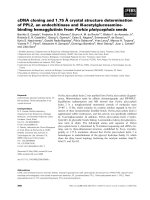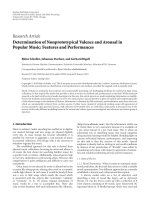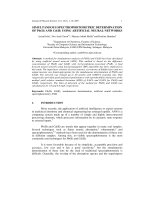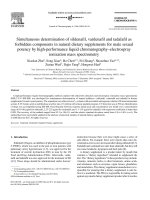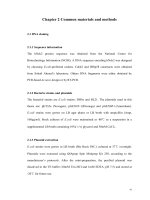Crystal structure determination of KREMEN1, DICKKOPF1 and MeCP2
Bạn đang xem bản rút gọn của tài liệu. Xem và tải ngay bản đầy đủ của tài liệu tại đây (1.84 MB, 108 trang )
CRYSTAL STRUCTURE DETERMINATION OF KREMEN1,
DICKKOPF1 AND MeCP2
VINDHYA B.N.REDDY
NATIONAL UNIVERSITY OF SINGAPORE
2008
CRYSTAL STRUCTURE DETERMINATION OF KREMEN1,
DICKKOPF1 AND MeCP2
VINDHYA B.N.REDDY
A THESIS SUBMITTED FOR THE DEGREE OF MASTER OF
SCIENCE
DEPARTMENT OF BIOLOGICAL SCIENCES
NATIONAL UNIVERSITY OF SINGAPORE
2008
ACKNOWLEDGEMENTS
Firstly, I would like to express my greatest gratitude to my supervisor, Dr. K.
Swaminathan for giving me an opportunity to work on these valuable projects and get
experience in the field of Structural Biology and X-ray crystallography; for being patient
with my flaws; for extending a lot of technical support and guidance and for the constant
encouragement throughout my tenure as a graduate student. I would like to express my
wholehearted thankfulness to him for all the support and knowledge he has imparted to
me.
I warmly thank our collaborators from the University of Pennysylvania, Prof.
Sarah Miller and Prof. Mariuz Wasik for helping us with the start of all the projects. I
owe my most sincere gratitude to Dr. Davis Ng and Dr. Kazue Kanehara from the
Temasek Lifesciences Laboratories, Singapore for their untiring help with experiments in
the yeast system and clarification of my doubts and queries on that regard.
I would like to thank all my co-workers in the lab and my very good friends,
Anupama, Toan, Kuntal, Pankaj, Dileep and Sunil for all the special moments we have
shared and for the kind encouragement, constant help and support. Special thanks to
Shiva for the constructive suggestions related to wet-lab experiments and bioinformatical
analysis, kind support and all the help during difficult moments in the lab.
I warmly thank, with best regards, all the members of Structural Biology lab 5 for
their comments and expert guidance on wet-lab experiments. I also wish to thank my
friend Karthik from SBL-2 for guidance in performing Circular Dichroism experiments
and many valuable suggestions.
i
Special and heartfelt thanks to all my family members, relatives and friends
outside NUS. My parents and sister have provided me with the best long distance
support, love and encouragement possible during my stay in Singapore. The foundation
that they have laid for me and the incessable morale boost cannot be thanked with words.
Thanks to my very special friends, Tanushree, Suguna, Kirthan and Nilofer for being
there with me during all fun-filled and difficult moments in Singapore.
My sincere thanks are due to the thesis committee members Drs. He Yuehui and
Prasanna Kolatkar for their constructive criticism and excellent advice during the
preparation of this thesis.
The financial support from the Department of Biological Sciences, National
University of Singapore is gratefully acknowledged.
ii
TABLE OF CONTENTS
Acknowledgements
i
Table of contents
Summary
iii
viii
List of abbreviations
x
List of figures
xiii
List of tables
xvi
CHAPTER 1 INTRODUCTION
1.1
WNT SIGNALLING PATHWAY: BIOLOGICAL BACKGROUND
1
1.2
CANONICAL WNT/ β-CATENIN PATHWAY
2
1.3
ANTAGONISTS OF WNT PATHWAY
4
1.3.1
Dickkopf-1 protein: significance and characterisation
4
1.3.1.1 Homology of Dkk-1with Colipase family
6
Kremen-1: characterisation and biological function
7
1.3.2
1.4
1.5
WNT ANTAGONISTS IN ACTION: INTERACTION OF
DKK-1/KRM/LRP5/6
8
DNA METHYLATION
11
1.5.1
Methyl-CpG binding proteins (MeCP2)
12
1.5.2
Structure of MBDs
13
1.5.3
MeCP2
15
1.5.4
Architecture of MeCP2
16
1.5.5
Role of MeCP2 in transcription repression
16
1.5.6
MeCP2 and Rett Syndrome
18
iii
1.6
1.7
1.8
1.9
STRUCTURE DETERMINATION OF PROTEINS
18
1.6.1
History and application of macromolecular X-ray crystallography 19
1.6.2
Protein crystallisation
19
BASIC CONCEPTS IN PROTEIN CRYSTALLOGRAPHY
20
1.7.1
Lattices, point groups and space groups
21
1.7.2
hkl plane
22
1.7.3
Principle of X-ray diffraction and Bragg’s law
23
1.7.4
Reciprocal space
24
1.7.5
The Ewald sphere
25
1.7.6
Fourier transformation and structure factor equation
25
1.7.7
Phase problem
26
STRUCTURE DETERMINATION
27
1.8.1
Solution to phase problem
27
1.8.2
Direct methods
27
1.8.3
Molecular replacement (MR)
28
1.8.4
Multiple isomorphous replacement (MIR)
28
1.8.5
Anomalous scattering
29
1.8.5.1 MAD
29
1.8.5.2 SAD
30
1.8.6
Phase improvement
30
1.8.7
Model building and refinement
31
1.8.8
Validation and structure deposition
32
OBJECTIVES OF THE PROJECTS
33
iv
CHAPTER 2 MATERIALS AND METHODS
2.1
2.2
2.3
2.4
2.5
PREPARATION FOR TARGET GENE AMPLIFICATIONS
35
2.1.1
Generation of cDNA using RT-PCR
35
2.1.2
Primer design for PCR
36
PCR OPTIMISATION PROCEDURE
36
2.2.1
Kremen1
36
2.2.2
Dickkopf1 (Dkk1 FL and Dkk1 Cys2) and MeCP2
37
2.2.3
Agarose gel extraction of the PCR products
37
CLONING
38
2.3.1
pGEM-T-Easy cloning vector
38
2.3.2
Preparation of E. coli DH5α competent cells
38
2.3.3
Transformation into DH5α Competant cells
and blue-white screening
39
SCREENING OF TRANSFORMANTS
39
2.4.1
Colony PCR screening
39
2.4.2
Double digestion screening
40
2.4.3
Agarose gel electrophoresis
41
2.4.4
Plasmid DNA sequencing
41
2.4.4.1 Cycle sequencing PCR
41
2.4.4.2 Ethanol precipation
42
SUBCLONING INTO EXPRESSION VECTORS
42
2.5.1
Subcloning target genes into E. coli and baculovirus vectors
42
2.5.2
Subcloning of gene targets into S. cerevisiae
43
v
2.5.3
2.6
2.7
Phenol/ chloroform treatment and ethanol precipitation
PROTEIN EXPRESSION AND PURIFICATION
44
2.6.1
Transformation and small scale expression in E. coli
44
2.6.2
Protein expression in yeast
46
2.6.2.1 Transformation in Yeast (W303a, pep4::HIS3 strain)
46
2.6.2.2 Preparation of protein for western blotting
46
2.6.2.3 Western blotting
47
PROTEIN PURIFICATION
48
2.7.1
Using affinity chromatography
48
2.7.2
Enterokinase cleavage
50
2.7.3
Thrombin cleavage
50
2.7.4
Gel filtration
50
2.7.5
Sodium dodecyl sulphate polyacrylamide gel
electrophoresis (SDS-PAGE)
2.8
2.9
44
51
BIOPHYSICAL CHARACTERISATION
51
2.8.1
Analysis of purity and homogeneity
51
2.8.2
Circular dichroism
52
CRYSTALLISATION TRIALS
52
CHAPTER 3 RESULTS AND DISCUSSION
3.1
PCR OPTIMISATIONS
53
3.2
MOLECULAR CLONING
55
3.2.1
T/A cloning and blue white screening
55
3.2.2
Subcloning of the gene inserts into expression vectors
56
vi
3.3
3.4
PROTEIN EXPRESSION TRIALS
60
3.3.1
60
Expression in E. coli
REASONS FOR PROTEIN EXPRESSION FAILURE
AND REMEDIES
65
3.4.1
Co-expression of Proteins
67
3.4.2
Expression in yeast (S. cerevisiae)
67
3.5
EXPRESSION AND PURIFICATION OF HIS-TAGGED Dkk1Cys2
3.6
ANALYSIS OF PROTEIN PURITY, HOMOGENITY
68
AND MOLECULAR WEIGHT
71
3.7
CIRCULAR DICROISM OF Dkk1Cys2
73
3.8
PEPTIDE MASS FINGERPRINTING (PMF)
74
3.9
EXPRESSION AND PARTIAL PURIFICATION OF MeCP2
75
CHAPTER 4 CONCLUSIONS AND FUTURE WORK
79
REFERENCES
82
vii
SUMMARY
The Kremen1 and Dickkopf1 proteins form an exclusive class (the Dkk class) of
evolutionarily well conserved antagonists of the canonical WNT/β-catenin pathway.
Their role is to regulate vertebrate development by maintenance of an important
constituent, β-catenin at levels desired to perform its necessary function. The proteins
have been characterised with their respective domain architectures and mutual binding
has been established in vivo, through co-immunoprecipitation and co-transfection studies.
The mechanism underlying the binding of the two proteins to further the process of WNT
inhibition has been intriguing. We have undertaken the crystal structure determination of
Krm1, Dkk1FL and the Krm1-Dkk1Cys2 complex.
We have been able to express and purify one of the crucial domains of Dkk1 from
Mus musculus, proved to be necessary and sufficient in binding with Krm1 and to inhibit
Wnt signalling. The 78 aa containing C-terminal domain of Dkk1, Dkk1Cys2, has been
cloned in the pET32a vector and expressed in the E. coli BL21 (DE3) host strain. The
protein has been purified to homogeneity and is presently under crystallisation trials.
Krm1 from Mus musculus was cloned into pET32a and found to express completely in
inclusion bodies in E. coli. Several attempts for expression have failed in both E. coli and
S. cerevisiae.
MeCP2 is another important mammalian protein with a role in the maintenance
of DNA methylation that is essential for mammalian development. It shares about 70%
identity with the MBD family of proteins, whose MBD domains are evolutionarily
conserved. The lack of functional similarity between these proteins outside this domain is
worth investigation. The structures of the MBD domain from MBD1 and MeCP2 have
viii
been determined by NMR and are found to be very similar. However, the pathway that
MeCP2 chooses for achieving transcriptional repression is still under investigation.
Additionally, there is a proposed model in the structural context of MeCP2 being
involved in a medically significant neurological disorder, the Rett syndrome. We attempt
to address the alteration of its DNA binding function and the above questions by solving
the structure of full length MeCP2 using X-ray crystallography.
MeCP2 from Homo sapiens has been cloned into vectors compatible with E. coli
and some soluble protein expression has been detected during initial trials. Protein
expression trials are currently underway for Krm1, Dkk1FL and also for MeCP2 in the
baculovirus expression system.
ix
LIST OF ABBRIEVATIONS
aa
ACT
AP
APC
AT
C
C/COOH
CBP
CD
cDNA
CIP
CK1
CNS
COL
CRD
CRID
Cys2
DEPC
dhkl
Dkk
DLS
DMSO
DNA
dNTP
Dsh
DTT
E
E. coli
ECD
ECL
EtBr
F
Fhkl
f(j)
FL
Fz
g
GAL
GPI
GSK3β
GST
HDAC
His-Pro
I
Amino Acid
Actin
Alkaline Phosphatase
Adenomatous polyposis coli
Adenosine: Thymine
End-centered
Carboxy terminal
Creb binding protein
Circular Dichroism
Complementary DNA
Calf Intestinal Phosphatase
Casein kinase 1
Central Nervous System
Colipases
Cysteine-rich domain
Co-repressor interacting domain
Cysteine Rich Domain 2
Diethylpyrocarbonate
Interplanar Spacing
Dickkopf
Dynamic Light Scattering
Dimethyl Sulfoxide
De-oxy ribonucleic acid
Deoxyribonucleotide triphosphate
Dishevelled
Dithiothreitol
Embryonic day
Escherichia coli
Extracellular domain
Enhanced Chemiluminescence
Ethidium Bromide
Face-centered
Structure factor
Scattering factor
Full Length
Frizzled
Relative Centrifugal force
Galactose
Glycosylphosphatidylinositol
Glycogen synthase kinase-3β
Glutathione S-transferase
Histone deacetylase Complex
Histidine and Proline rich region
Body-centered
x
IgG
IPTG
Kd
Krm
L
LB
LEF
LRP
MAD
MBD
mCpG
MCS
MeCP
MES
MIR
MR
mRNA
MW
MWCO
N/NH2
NMR
P
PBS
PCP
PCR
PDB
pI
PLATE
PMF
Psi
PVDF
RE
R-factor
Rpm
RT
S. cerevisiae
SAD
SC-Ura
SDS-PAGE
sFRP
Sk
TAE
TCA
TCF
TFIIB
TM
Immunoglobulin G
Isopropyl β-D-1-thiogalactopyranoside
Dissociation constant
Kremen
Loop
Luria-Bertani
Lymphoid enhancer factor
Low-density lipoprotein receptor related protein
Multiwavelength Anomalous Dispersion
Methyl-CpG Binding domain
Methyl Cytidine (phospho-diester bond) Guanosine
Multiple Cloning Site
Methyl-CpG Binding Protein
2-(N-morpholino)ethanesulfonic acid
Multiple Isomorphous Replacement
Molecular Replacement
messenger- Ribo-nucleic acid
Molecular Weight
Molecular Weight Cut Off
Amino terminal
Nuclear Magnetic Resonance
Primitive
Phosphate Buffer Saline
Planar Cell Polarity
Polymerase Chain Reaction
Protein Data Bank
Isoelectric pH
PEG/Li-acetate/TE
Peptide Mass fingerprinting
Pound per Square inch
Polyvinylidene difluoride
Restriction Enzyme
Residual/ Reliability Factor
Revolutions per minute
Reverse Transcriptase
Saccharomyces cerevisiae
Single Anomalous Dispersion
Synthetic Complete- Uracil
Sodium dodecyl sulfate- Polyacrylamide Gel Electrophoresis
Secreted Frizzled-related proteins
Soggy
Tris-acetate-EDTA
Trichloroacetic acid
T-cell factor
Transcription Factor IIB
Transmembrane
xi
TRD
Trx
U
UV
WIF
WNT
YPD
βME
θ
λ
ρ (x,y,z)
Transcription repressor domain
Thioredoxin
Unit(s)
Ultra Violet
WNT inhibitory factor
Wingless (Wg), WNT-1(int-1)
Yeast Peptone Dextrose
β-Mercaptoethanol
Angle of incidence
Wavelength
Electron density
xii
LIST OF FIGURES
Chapter 1
Page
Figure 1.1
Canonical WNT/β catenin signalling pathway
2
Figure 1.2
Schematic representation of Dkk-1 protein
5
Figure 1.3
Alignment of the Dkks with colipases and other
related molecules
6
Figure 1.4(a) A three-dimensional model of the colipase fold based on
porcine colipase structure
7
Figure 1.4(b) Domain organisation of colipase-containing proteins based on
sequence similarity
7
Figure 1.5
Sequence comparison of Krm proteins
10
Figure 1.6
Deletion analysis of Kremen and Dickkopf
11
Figure 1.7
Model for functional interactions of Dkk1, LRP5/6 and Krm
to block the Canonical Wnt signal in cells
11
Figure 1.8
Domain organisation of MBD family members
13
Figure 1.9
Sequence alignment of the MBD family proteins
14
Figure 1.10(a) Solution structure of the MBD of MBD1
15
Figure 1.10(b) Putative DNA binding site of MBD
15
Figure 1.11
Figure 1.12
Proposed potential mechanisms for repression
mediated by MBD proteins
17
The unit-cell
21
Figure 1.13(a) Constructive interference
23
Figure 1.13(b) Destructive interference
23
xiii
Figure 1.14
Bragg’s law
23
Figure 1.15
Reciprocal lattice
24
Figure 1.16
The Ewald sphere
25
Chapter 3
Page
Figure 3.1
PCR optimisations of Krm1
54
Figure 3.2
Touchup PCR products of MeCP2, Dkk1FL and Dkk1Cys2
55
Figure 3.3
Double digested products of Krm1 constructs
58
Figure 3.4
Double digested products of Dkk1FL constructs
58
Figure 3.5
Double digested products of MeCP2 constructs
59
Figure 3.6
Colony PCR products of Krm1 in PTS210
59
Figure 3.7
Colony PCR products of Dkk1FL in PTS210
60
Figure 3.8(a) Expression of Krm1 in pQE30 vector / M15 cells
62
Figure 3.8(b) Expression of Krm1 in pGEX 4T1 vector / BL21 (DE3) cells
62
Figure 3.8(c) Expression of Krm1 in pET32a vector / BL21 (DE3) cells
63
Figure 3.8(d) Expression of Dkk1FL in pGEX4T1 vector / BL21 (DE3) cells
63
Figure 3.8(e) Expression of Dkk1FL in pET32a vector / BL21 (DE3) cells
64
Figure 3.8(f) Expression of MeCP2 in pET14b vector / pLySS (DE3) cells
64
Figure 3.9
Western blot analysis of Krm1 and Dkk1FL
65
Figure 3.10
The Kyte-Doolittle hydropathy plot for Kremen1
68
Figure 3.11
Small Scale expression of Dkk1Cys2
69
Figure 3.12
Talon affinity purification of His-tagged Dkk1Cys2
70
Figure 3.13
Gel filtration profile of Dkk1Cys2 on a Sephadex-75 column
70
Figure 3.14
SDS gel of the thrombin cleaved Dkk1Cys2
71
xiv
Figure 3.15
Dynamic Light Scattering analysis of Dkk1Cys2
72
Figure 3.16
Native gel of Dkk1Cys2
73
Figure 3.17
CD Spectrum of Dkk1Cys2
73
Figure 3.18
Predicted secondary structure of Dkk Cys2
74
Figure 3.19
Peptide mass fingerprinting of Krm1
74
Figure 3.20
Peptide mass fingerprinting of Dkk1Cys2
75
Figure 3.21
Expression of MeCP2 in pET32a vector / BL21 (DE3) cells
76
Figure 3.22
Solubility check of MeCP2
76
Figure 3.23
Talon affinity purification of His-tagged MeCP2
77
Figure 3.24
Gel filtration profile of MeCP2 on Sephadex- 200 column
77
Figure 3.25
SDS-PAGE analysis of his-tagged MeCP2 elution fractions
78
xv
LIST OF TABLES
Page
Table 1.1
Crystal systems and their related unit-cells and lattices
22
Table 2.1
Expression trials for proteins
45
Table 3.1
Target proteins with the corresponding expression systems
and vectors used
Table 3.2
57
Summary of protein expression in E. coli, S. cerevisiae
and Baculovirus
61
xvi
CHAPTER 1: INTRODUCTION
1.1
WNT SIGNALLING PATHWAY: BIOLOGICAL BACKGROUND
The WNT/β-catenin canonical pathway is most extensively studied in cell
signalling. This pathway involves the evolutionarily conserved secreted WNT (Wingless
from Drosophila and Int-1 from Mus musculus) cysteine-rich glycoproteins (Clevers,
2006). About 19 members of the WNT protein family have been identified in mammals
and the functions of WNTs have been elucidated by genetic and cell biological studies in
models including Drosophila melanogaster, Danio rerio, Caenorhabditis elegans,
Xenopus laevis, Musmusculus, sea urchin, chicken embryos and mammalian cultured
cells (Moon et al., 2002; Moon et al., 2004). They act as short-range ligands that mediate
signalling through serpentine receptors of the Frizzled gene family.
WNTs work to regulate a wide range of developmental processes in both embryos
and adults (Wodarz and Nusse, 1998; Miller et al., 1999; Moon et al., 1997). These
comprise embryonic induction, generation of cell polarity, cell fate specification, cell
migration (Cadigan and Nusse, 1997), mammary gland and skin appendage
morphogenesis and hair follicle formation (Chu et al., 2004). In addition, deregulation in
WNT signalling that leads to elevated β-catenin levels has been largely implicated in the
genesis of a number of malignancies (Polakis, 2000; Morin, 1999; Miller et al., 1999;
Akiyama et al., 2000), degenerative disorders (Nusse, 2005) and several developmental
defects.
WNT genes are not functionally equivalent. They give rise to diverse pleiotropic
effects through activation of distinct intracellular pathways that abundantly exhibit cross-
1
talk with other signalling pathways (Moon et al., 1997). WNT proteins also depend on a
repertoire of receptors and co-factors present on the cell surface to determine the
transcriptional endpoints and hence, WNT target genes are mostly cell type specific. In
particular, three pathways have been identified, namely the WNT/Ca2+ cascade, planar
cell polarity (PCP) pathway or non-canonical WNT/ β-catenin pathway and the canonical
WNT/ β-catenin pathway.
1.2
CANONICAL WNT/ β-CATENIN PATHWAY
Our interest lies in the canonical WNT/β-catenin signalling pathway. WNT signal
transduction is mediated by the Frizzled (Fz) genes encoding seven transmembrane
receptor proteins (Vinson et al., 1989; Wang et al., 1996; Chan et al., 1992) with a
cysteine-rich domain (CRD) at the N-terminus which bind Wnts with high affinity (Hsieh
et al., 1999). However, the pathway diverges downstream of the Dishevelled protein and
acts through a core set of highly conserved proteins to regulate β-catenin levels in the
nucleus and cytoplasm (Fig. 1.1).
Figure 1.1. Canonical WNT/β-catenin signalling pathway in (a) absence
and (b) presence of WNTs, respectively. WNTs bind to Fz and LRP5/6 to
2
induce β-catenin release from the catenin destruction complex and its
subsequent translocation into the nucleus to activate gene transcription
(adapted from Moon et al., 2004).
In the absence of active WNT ligands, free cytoplasmic β-catenin is recruited into a
‘Catenin destruction complex’ assembled by the tumour suppressors, APC and Axin.
The multiprotein complex, including GSK3β and CK1 triggers phosphorylation of βcatenin at the N-terminal, leading to ubiquitylation followed by proteosomal degradation
of β-catenin. This leads to low cytoplasmic and nuclear β-catenin levels, and hence
inhibition of downstream gene transcriptional events (Moon et al., 2004).
Activation of the canonical signalling cascade is triggered when secreted WNT
ligands interact with Fz receptors through the CRD which then bind to the single-pass
transmembrane protein identified as the low-density lipoprotein receptor related proteins
5 and 6 (LRP5/6) in vertebrates and Arrow in the Drosophila (Tamai et al., 2000; He et
al., 2004) at the membrane surface. This results in the inhibition of GSK3β
phosphorylation of β-catenin by the dissociation of the enzyme from the destruction
complex (Willert and Nusse, 1998), possibly through the activation of Dsh. In addition,
Axin is also degraded, further decreasing β-catenin phosphorylation. As a result, the
stabilised β-catenin then accumulates in the cytoplasm before translocating to the
nucleus, allowing subsequent complex formation with the DNA bound transcription
factors, TCF and LEF. These repressed transcription factors activate important target
genes downstream, leading to a myriad of effects, most notably regulation of cell
proliferation, survival and cell fate.
3
1.3
ANTAGONISTS OF WNT PATHWAY
Several antagonists work in concert to dampen the WNT signalling pathway to
ensure target gene expression in the correct cellular and developmental context. Wnt
antagonism plays a central role in anterior specification during anteroposterior patterning
of neural plate during Xenopus gastrulation (Davidson, 2002). Wnt antagonists are of two
functional classes, the secreted Frizzled-related proteins (sFRP) class and the Dickkopf
(Dkk) class. Members of sFRP class include sFRP family, WNT inhibitory factor (WIF)
and Cerberus, exerting their effect by direct binding and sequestration of soluble WNTs
(Kawano and Kypta, 2003).
1.3.1 Dickkopf-1 protein: significance and characterisation
Inhibition of WNT signalling can be mediated by the members of the Dickkopf
(Dkk) family of proteins and in particular, Dkk1 (Glinka et al., 1998). The founding
member of the multigene Dkk family is Dkk-1, with three other members identified in
vertebrates, including Dkk-2, Dkk-3 and Dkk-4 (Krupnik et al., 1999; Monaghan et al.,
1999; Niehrs, 2006). Dkks are an evolutionarily ancient gene family, found in
vertebrates, including humans, and in invertebrates like Dictyostelium, Cnidarians,
Urochordates and ascidians but not in Drosophila and Coenorhabditis elegans. There is a
strong functional divergence between Dkk3 and Dkk1/2/4 gene families during early
metazoan evolution (Niehrs, 2006). Dkk1/2/4, all regulate Wnt Signalling and bind to
LRP6 and Krm1 and 2 unlike Dkk3 (Mao et al., 2002).
Dkks are glycoproteins of 255-350 aa, containing a signal sequence at N-terminus
and sharing two conserved characteristically spaced cysteine-rich domains. The N-
4
terminal cysteine-rich domain, Dkk_N (Cys1) is unique to Dkks and the C-terminal
cysteine-rich domain (Cys2) has a pattern of 10 cysteines related to colipase fold (Niehrs,
2006; Aravind and Koonin, 1998). Dkks play an important role in vertebrate
development, locally inhibiting Wnt regulated processes such as antero-posterior axial
patterning, limb development, somitogenesis and eye formation. In adults, Dkks are
implicated in bone formation and bone disease, cancer and Alzhiemer’s disease (Niehrs,
2006). The characteristic developmental function of Dkk-1 is its head inducing activity
(Mukhopadhyay et al., 2001; Glinka et al., 1998). A human homologue of Dkk1, Soggy
(Sk) (Fig. 1.2), has been characterised biochemically and is found to complement Dkk1
function in Xenopus laevis (Fedi et al., 1999).
a
b
Figure 1.2. Schematic representation of Dkk-1 protein. (a) Dkk-1
Architecture representing the C1 and C2 domains and percentage identity
between human and mouse or Xenopus cysteine-rich domains. SP: Signal
Peptide; C: Cysteine; N: N-glycosylation site (b) Consensus of Dkk-1
5
sequence from human, mouse and Xenopus cysteine-rich domains.
(adapted from Fedi et al., 1999).
1.3.1.1 Homology of Dkk-1with Colipase family
The structural and sequence homology between colipase and the C-teminal
domain of Dkk has been recently discovered (Figs. 1.3 and 1.4). It has been convincingly
suggested that Dkks and colipases have the same disulfide-bonding pattern and a similar
fold. The structure of colipase fold is solved using X-ray crystallography and it consists
of short β-strands connected by loops and stabilised by disulfide bonds, resulting in
finger-like structures that may serve as interactive surfaces for lipases (Tilbeurgh et al.,
1999).
Figure 1.3. Alignment of the Dkks with colipases and other related
molecules. Xdkk-1 and Mdkk-1 are the Dkks from Xenopus laevis (XI)
and Mus musculus (Mm) respectively. COL stands for the colipases. The
conserved residues are colored according to the 85% consensus rule: polar
residues, red; acidic and basic residues, pink; hydroxylic residues, blue;
hydrophobic residues, yellow background; tiny residues, green
background; small residues, blue backgroud; large residues, gray
background. The conserved cysteines, which form the disulfide-bonding
pattern typical of this family, are shown in inverse red shading. The
disulfide-bonding network connecting the cysteines is shown in a separate
color for each pair. The predicted structural elements based on the porcine
colipase crystal structure are shown above the alignment, with arrows
representing β-strands (adapted from Aravind and Koonin, 1998).
6
The position of the hydrophobic amino acid residues are conserved well between the
carboxy-teminal domain of Dkk and the colipases. One direct functional implication of
this observation is that the colipase-like domain of Dkk may be necessary for the
membrane association of this protein, which in turn may be required for the inhibition of
Wnt secretion or Wnt-receptor interaction (Aravind and Koonin, 1998).
Figure 1.4. (a) A three-dimensional model of the colipase fold on the
basis of the porcine colipase crystal structure. The β-strands are shown in
yellow, the loops in blue and the disulfide bonds in pink. The hydrophobic
residues (in the single-letter amino-acid code) are possibly involved in
lipid interaction, are shown as space-filling spheres in gold (b) Domain
organisation of the colipase-domain-containing proteins based on
sequence similarity. Blue: signal peptide; green: N-terminal cysteine-rich
domain; red: colipase domain; thick bar: 100 amino acids. (adapted from
Aravind and Koonin, 1998).
1.3.2 Kremen-1: characterisation and biological function
Kremens are type-I transmembrane proteins, composed of 473aa, Fig. 1.5. There
are two related forms of Krm (Krm1, Krm2), identified to be widely expressed in adult
tissues, including the skeletal muscle, brain and during embryonic development. It
consists of three conserved extracellular domains, namely the kringle domain, Wsc and
7
